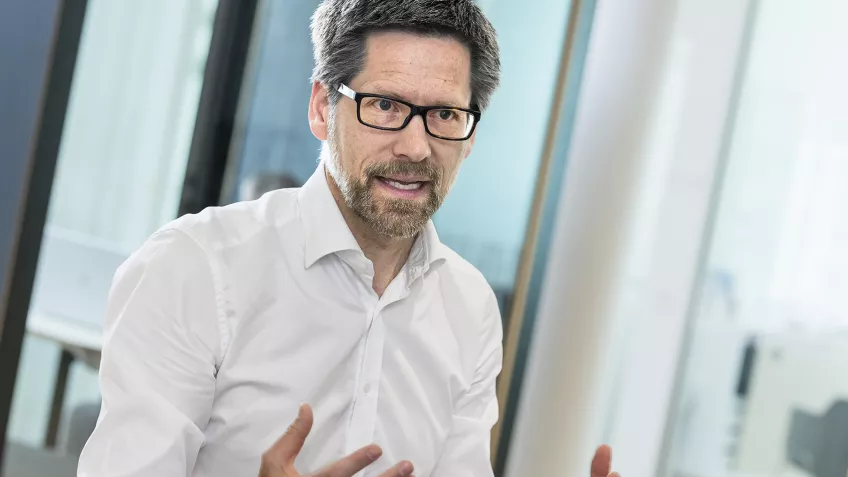
As part of our ongoing work to reduce the environmental impact of our own operations and across our entire value chain, Axis has recently committed to set science-based targets to reduce emissions in line with the Science Based Targets initiative (SBTi). We met with Ray Mauritsson, Axis CEO, and Carl Trotzig, Director, Quality and Environment at Axis to hear why a commitment to science-based targets is so important to Axis, and the implications for our global partners and suppliers.
Why has Axis decided to set science-based targets in line with the SBTi?
Ray Mauritsson: It’s a logical step for us. We signed the United Nations Global Compact in 2007, and given the UN Global Compact is one of the organizations involved in the SBTi, we’ve been aware of the initiative for some time. We believe that setting science-based targets for reducing emissions is the most effective way for Axis – and indeed any business – to take the urgent action required to address climate change. Setting targets that are ratified and reviewed by the SBTi will ensure that they are not only ambitious enough, but that we’re being held accountable for achieving them.
What specifically has Axis committed to do, and when by?
Carl Trotzig: To use the formal description, we have committed to set science-based emissions reduction targets in line with the level of decarbonization required to meet the goals of the Paris Agreement, which is to limit global warming to well-below 2°C above pre-industrial levels and pursue efforts to limit warming to 1.5°C. The timeline set out by the SBTi gives us two years to set targets, but we’re looking to set the targets sooner than that, hopefully within a year. That said, the SBTi has to ratify the targets we propose as being ambitious enough to support its goals - we’ll be following the SBTi standards to make sure of that.
How does this fit with the current initiatives Axis has in place around its environmental impact?
Ray: We have three pillars under which all of our environmental initiatives align: protect natural resources, protect ecosystems, and beat climate change, so there’s an obvious alignment. However, the important thing about the targets we’ll set within the SBTi will be the level of focus and accountability they’ll bring to our business and, importantly, our entire value chain.

Carl: This is a critical point. The science-based targets we set will apply to our entire value chain, upstream and downstream. That’s vital – we can’t claim to be doing all we can as a business if our suppliers and partners aren’t adhering to the same standards. We already do a lot of work around sustainability in our supply chain – from product design and material choices to reducing packaging and optimization of transport – and these targets will increase those efforts.
What is the process beyond the target setting?
Carl: The targets that we set and which the SBTi will hopefully ratify will define the overall goals in emissions reduction across our organization and value chain. Achieving these targets will be the product of many small and specific initiatives, each of which will have its own plan of action and measures. Clearly there’s going to be a lot of work needed within our own business, and a lot of collaborative work with our partners and suppliers. We have the advantage that we won’t be starting from point zero, however, given we’ve been working towards improved sustainability for many years ourselves and throughout our supply chain. And our annual Sustainability Report, which we’ve published for a number of years, will be the primary means of reporting on our progress towards the targets when set and agreed.
Yes, you’ve mentioned that the scope of the targets will extend across the Axis value chain. How do you think suppliers and partners will respond?
Ray: We’re confident it will be a positive response. While it’s a logical step for Axis, it’s also logical that we would bring our suppliers with us on that journey. As Carl says, our suppliers and partners know that we have a clear focus on improving sustainability in general across our value chain, and specifically in reducing the environmental impact of our operations. In many ways, we’ve spent years building a supply chain which reflects our own values, so speaking to our suppliers and partners about aligning to science-based targets should be welcomed. We’ve also mentioned the importance of accountability. We’re determined to achieve the targets we set, and therefore our community of global suppliers and partners will need to play their part.
Do you see other positives from such a clear focus on reducing emissions?

Carl: Absolutely. The setting and work towards achieving the science-based targets will support innovation across our business operations. In product development and design, in how and where we source components, in where we locate manufacturing facilities and logistics centers, in the sources of our energy, in how decommissioned products are taken care of, in the transportation of our products and in our travel individually for business…there won’t be a part of our business unaffected. This will be a huge opportunity to reengineer our organization and value chain for long-term environmental benefit.
Ray: Ultimately, these actions are no longer a “nice to have”, they’re essential. We all have a responsibility – individually as well as in business – to change our behavior to address climate change and ensure the future of the planet. We’ll continue to play an active role.